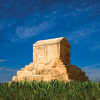
Pasargadae
PasargadPasargadae complex is an ancient area, including a large number of structures which was remained from the first capital of the Achaemenid era (sixth century BC) in Iran, located in the valley of Polvār River, and established by Cyrus the Great.
This complex belongs historically to three periods: (1) Prehistoric and Pre- Achaemenid monuments; (2) Achaemenid era: includes a private palace of Cyrus, the reception hall or Cyrus Bār-e-ām (public permission), the gateway palace or eastern palace protected by Lamassu, a relief of mythological creature made of stone, a stony terrace called " Throne of the Mother of Solomon" (Takht-e mādar-e Soleymān) (the Defensive structure of Tal-e Takht), the Royal Garden of Pasargadae, the royal palace fountains, the stone basins, ruins of stone tower, a building known as prison, fortress of Pasargadae, Pasargadae fire temple and sacred area, and finally the Cyrus tomb (the most prominent part of the site); (3) Islamic monuments: Atabakān mosque, an inscription and carved altar in the Cyrus mausoleum, an Islamic building named Mozaffari School or caravanserai located in 1 hundred meters north of Cyrus mausoleum. Bolāghi Tangeh and the incomplete Pasargadae museum are also among the other parts of this complex.
Pasargadae ancient complex made of materials as stone, brick, mud brick and wood, is representative of the first step of flourishing and development of architecture, sculpture, painting and simulating arts in the Achaemenid era, which is considered to be a model for Persepolis; it is an exceptional testimony of Iranian civilization.
https://whc.unesco.org/en/list/1106